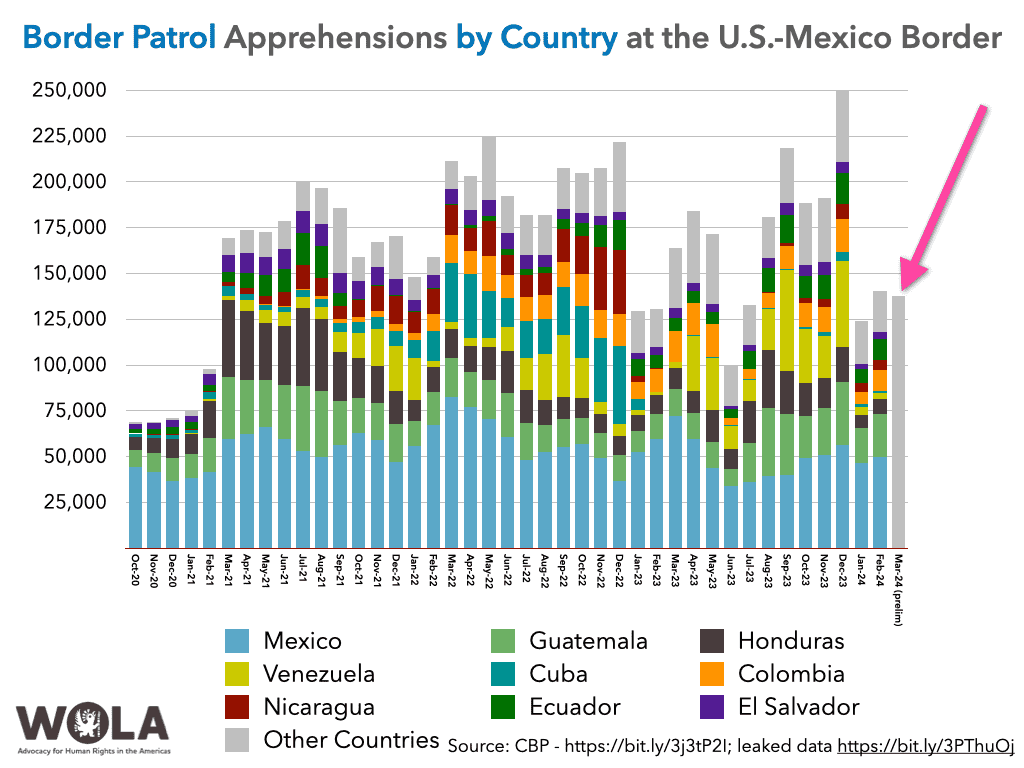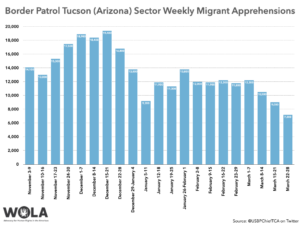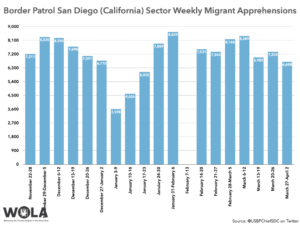With this series of weekly updates, WOLA seeks to cover the most important developments at the U.S.-Mexico border. See past weekly updates here.
Support ad-free, paywall-free Weekly Border Updates. Your donation to WOLA is crucial to sustain this effort. Please contribute now and support our work.
The number of migrants entering Border Patrol custody declined from February to March, by about 2 percent, according to preliminary data. Migration usually increases in spring: this is only the second time this century that Border Patrol has recorded a February-to-March decline. Increased enforcement in Mexico may be a cause. Weekly data show Border Patrol apprehensions declining in Arizona and California from the beginning of March to the end of March.
A 24-year-old Guatemalan woman’s fatal March 21 fall from the border wall in San Diego drew new attention to the region’s sharply increased numbers of wall-related deaths and injuries. Elsewhere in San Diego, a federal judge ruled that outdoor encampments where Border Patrol makes asylum seekers wait to be processed violate a 1997 agreement governing the treatment of children in the agency’s custody.
“Now, to be fair, maybe Texas went too far,” said Texas’s solicitor general in arguments before the Fifth Circuit Court of Appeals, which is considering the constitutionality of the state’s harsh new law, S.B. 4. The law, if allowed to go into effect, would permit Texas law enforcement to arrest, imprison, and even deport people for the crime of illegal entry from Mexico. However the appeals court rules, the law is almost certainly headed for the Supreme Court.
Panamanian authorities report that an average of 1,200 people per day migrated through the treacherous Darién Gap jungle region during the first quarter of 2024, well ahead of 2023’s record-setting pace. Human Rights Watch published a big report finding fault with the Colombian and Panamanian government’s responses to Darién Gap migration, and calling for the U.S. and other governments to expand legal migration pathways. The New York Times documented the alarming recent increase in cases of sexual assault committed against migrants in the Darién.
For the second consecutive month, Ali Bradley of the right-leaning NewsNation media outlet published leaked CBP migration data from March to her social media accounts. (Bradley’s early March leak of February data turned out to be very close to the official February count released weeks later.)

Bradley reported 137,557 Border Patrol apprehensions of migrants at the border in March, which would be a 2 percent decrease from February. April 4 reports from CBS News and the Washington Examiner confirmed this overall total.
This is only the second time, in the 25 years for which we have data, that migration declined from February to March. It is unusual for migration to decline in springtime, when the weather improves.
The leaked data show that migration has increased since February from three countries (Mexico +5%, Venezuela +88%, Ecuador +35%) and decreased from two (Guatemala -35%, Cuba -4%).
This would be an important increase in migration from Venezuela. During January and February, as noted in WOLA’s March 29 Border Update, U.S. encounters with Venezuelan migrants lagged far behind Mexico’s, indicating that a large number of Venezuelan migrants have been stuck in Mexico.
The leaked data indicate greater migration in two Border Patrol sectors (San Diego, California +7% and El Paso, Texas +27%) and reduced migration in another two (Tucson, Arizona -15%, Del Rio, Texas -20%).
Weekly Twitter posts from the chiefs of Border Patrol’s Tucson and San Diego sectors show a downward trend over the course of March in both sectors. From the first to the fourth week of March, the number of migrants whom Border Patrol apprehended in its busiest border sector—Tucson, Arizona—dropped by 5,000 or 41 percent, according to those updates. Tucson agents apprehended 12,200 migrants during the week of March 1-7; that number has declined during each subsequent week, reaching 7,200 during March 22-28.


In San Diego, Border Patrol migrant encounters were 20 percent fewer the week of March 27-April 12 than they were three weeks earlier (March 6-12).
The reductions in Arizona and California appear to puncture the narrative that the Texas state government’s harsh border measures are pushing migration to other border states.
Border-wide, the unusual spring lull in migration appears to be resulting from changes in Mexican government counter-migrant operations. In January and February, Mexican officials reported encountering 240,000 migrants—120,000 per month, far more than the Mexican government’s previous monthly record.
The crackdown, which came after record migration at the U.S.-Mexico border in December, appears to coincide with the weeks after a December 27 visit to Mexico City of the U.S. secretaries of state and homeland security, at which they appealed for help stemming the flow of people through Mexican territory.
Mexico’s response was evident this week in Ciudad Juárez, across the Rio Grande from El Paso. (As noted above, migration has increased in Border Patrol’s El Paso sector.) On April 1, Border Report reported that Mexican authorities began surging police, immigration agents, and National Guard personnel to their side of the border between Ciudad Juárez and El Paso. Mexico’s government deployed more than 200 immigration agents.
The operation is to expand from the borderline to the southern parts of Mexico’s border state of Chihuahua, of which Ciudad Juárez is the largest city, reported La Verdad de Juárez.
The agents are apprehending undocumented migrants and, when possible, transporting them away from Mexico’s northern border zone. Though just 6,500 of Mexico’s 240,000 January-February migrant encounters ended in deportations out of the country, its government has massively bused migrants to the country’s center and southern regions.
As a result of this tactic, ten humanitarian organizations in Mexico City warned of the increasingly precarious situation of migrants from many countries stranded in Mexico’s capital. Most are attempting to secure online CBP One appointments at U.S.-Mexico border ports of entry. Geolocation restrictions prevent the scheduling app from functioning when used south of Mexico City.
The Mexican government operation, La Verdad recalled, was launched “five days after the one-year anniversary of the fire in a migrant detention facility in Juárez that killed 40 migrants and injured 27 others.” The detention facility fire took place two months after a similar deployment of over two hundred INM agents to Juárez. Many of the migrants who died on March 27, 2023, had been rounded up in raids throughout the city.
Agents in Juárez are breaking up migrant encampments near the Rio Grande, where Texas state national guardsmen are preventing people from approaching the U.S. border wall and turning themselves in to federal Border Patrol agents to ask for asylum.
A much-circulated March 21 video from the El Paso side of the river had shown a group of migrants pushing past Texas state guardsmen in order to reach the border wall and seek to turn themselves in to Border Patrol. 214 people were arrested and booked into the El Paso County jail. Of those, all but 39 have been released into Immigration and Customs Enforcement (ICE) custody. Many are contesting criminal charges of “rioting.”
South of San Diego, migrants are reporting abuse at the hands of Mexican National Guard personnel whom Mexico’s government recently deployed to sites east of San Diego where asylum seekers attempt to cross and turn themselves in to Border Patrol. A woman from Ecuador told Border Report that guardsmen separated women from the group with which she was traveling, groped them, and demanded bribes of $2,500 per person. Others spoke of demands for $800 payments and theft of belongings.
A San Diego NBC affiliate added more detail to the account, summarized in a March 29 CBP release, of a 24-year-old Guatemalan woman’s fatal March 21 fall from the border wall between Tijuana and San Diego. The woman had been hanging from the wall and yelling for help for about 24 minutes before she let go and fell to her death from the 30-foot, Trump-era structure.
A fire truck initially showed up at the wrong side of the wall, and was unable to arrive at the woman’s location in time. The woman fell while fire department personnel were en route, about a minute after a Border Patrol agent left the scene “to meet with other agents and coordinate the transportation of other migrants apprehended in the area.”
A spokesperson for the San Diego Fire Department said, “CBP did the right thing by telling us the height of the wall at that initial location, but CBP did not provide SDFD with the best access point to the patient.” CBP will release body-worn camera footage of the incident.
An article in the medical journal Cureus found “lower extremity” and “lumbar spinal” injuries to be common in a sample of 108 people who had fallen from the border wall between 2016 and 2021. As noted in WOLA’s March 15 Border Update, last year U.C. San Diego Health “saw 500 head injuries” from migrants who had fallen from the wall between San Diego and Tijuana, “with many patients needing surgery,” according to San Diego’s ABC TV affiliate.
East of San Diego, the New York Times reported from an open-air holding site in the mountains near Jacumba Springs and Campo, California, where asylum seekers often must wait outdoors for days for the opportunity to turn themselves in to Border Patrol. Agents provide no shelter, food, water, or medical care; that is up to volunteers.
“The situation in San Diego County is part of a broken system in which border enforcement funding is prioritized above building the necessary infrastructure to humanely process a historic number of asylum seekers,” human rights researcher Claudia Villalona reported in The Progressive following a visit to the encampments.
On March 29 U.S. District Judge Dolly Gee, who oversees the 1997 Flores settlement agreement governing the treatment of children in CBP custody, presided over a hearing about the health and child welfare risks of forcing people to wait in the outdoor encampments. Government attorneys argued that migrants at the camps are technically not in U.S. custody and don’t require care.
On April 4 Judge Gee ruled that Border Patrol must care for children in the encampments, finding that they are effectively in U.S. custody and that the Flores settlement agreement applies to them. By May 10, CBP’s juvenile coordinator must provide a report about the number of children present at the outdoor camps and the steps the agency is taking to care for them.
The decision is a victory for the National Center for Youth Law, the Center for Human Rights and Constitutional Law, and Children’s Rights, which filed a motion before Judge Gee’s court, and for groups that have been providing aid and filing complaints, like Al Otro Lado, American Friends Service Committee, Universidad Popular, and the Southern Border Communities Coalition.
In an hour-long April 3 hearing in New Orleans, the Fifth Circuit Court of Appeals heard arguments about Texas’s controversial state law S.B. 4, which would allow state officials to arrest, imprison, and deport migrants for illegal entry.
The law raises the specter of states enforcing their own immigration laws, and of Texas law enforcement profiling people and demanding they prove their status anywhere in the state.
“Now, to be fair, maybe Texas went too far,” the state’s solicitor-general surprisingly said during the hearing. “What Texas has done here, they have tried to develop a statute that goes up to the line of the Supreme Court precedent but allows Texas to protect the border.”
The Texas official, Aaron Neilson, said that when arrested migrants are found guilty and agree to be deported instead of jailed, Texas authorities would hand them over to U.S. officials at border ports of entry, rather than carrying out their own deportations into Mexico. Neilson “then stumbled to explain how that is different from what is happening at the border now,” the Associated Press reported.
It is not clear when the appeals court will rule on S.B. 4’s constitutionality; the same three-judge panel already stayed the law while its deliberations continue. Regardless of the outcome, the challenge to the law—led by the federal Justice Department, joined with a suit brought by the ACLU and local organizations—is almost certain to go to the Supreme Court.
A CNN analysis recalled that Texas’s goal is probably to get a now more conservative Supreme Court to revisit a 2012 ruling that struck down a harsh law that Arizona passed in 2010.
Two attorneys from the WilmerHale firm, writing for Bloomberg Law, found zero basis for Texas Gov. Greg Abbott’s (R) claim, in defense of S.B. 4, that migration to his state meets the constitutional definition of an “invasion.”
At the end of the first quarter of 2024, the number of people who have migrated through Panama’s Darién Gap stands at 109,069, up from 87,390 during the same period in 2023. The month-to-month trend is flat, though: 36,001 people in January, 37,165 in February, and 35,903 in March. Migration has been more or less steady at a rate of about 1,200 people per day.
Of this year’s migrants, 69,568 (64 percent) have been citizens of Venezuela, a proportion similar to 2023.
A new Human Rights Watch (HRW) report on migration through the treacherous jungle region finds fault with the Colombian and Panamanian governments’ failure to protect the more than 40,000 people per month who have been passing through the treacherous jungle route. The 25,000-word report, a follow-up to an earlier report published in November, finds that the two governments, whose territory includes the Darién, do not do enough to coordinate their response.
The report calls on the U.S. government and other international actors to establish other legal migration pathways including “a region-wide temporary protection regime that would grant all Venezuelans and Haitians temporary legal status,” and to fund humanitarian responses.
HRW Americas Director Juanita Goebertus called out Panama for its recent suspension of Doctors Without Borders (MSF), which had been providing medical care at the Panamanian end of the Darién trail. MSF had been vocally calling for action about the rising number of cases of sexual abuse on the Darién route.
Shortly before being kicked out in early March, the organization denounced a sharp increase in their medical personnel’s encounters with victims of sexual violence at Darién Gap health posts: 233 cases in 2024’s first two months after 676 cases in 2023, of which a majority occurred during the final 3 months of last year.
On April 4 the New York Times’s Julie Turkewitz published a report highlighting worsening levels of sexual violence that criminal gangs commit against migrants passing through the Darién Gap. The report features an evasive answer from a U.S. diplomat in Panama, and questions the Panamanian government’s decision to suspend MSF. Panamanian government officials, it notes, have been facilitating the work of far-right U.S. social media influencers visiting the region.